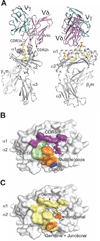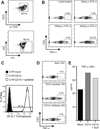Crystal structure of Vδ1 T cell receptor in complex with CD1d-sulfatide shows MHC-like recognition of a self-lipid by human γδ T cells
- PMID: 24239091
- PMCID: PMC3875342
- DOI: 10.1016/j.immuni.2013.11.001
Crystal structure of Vδ1 T cell receptor in complex with CD1d-sulfatide shows MHC-like recognition of a self-lipid by human γδ T cells
Abstract
The nature of the antigens recognized by γδ T cells and their potential recognition of major histocompatibility complex (MHC)-like molecules has remained unclear. Members of the CD1 family of lipid-presenting molecules are suggested ligands for Vδ1 TCR-expressing γδ T cells, the major γδ lymphocyte population in epithelial tissues. We crystallized a Vδ1 TCR in complex with CD1d and the self-lipid sulfatide, revealing the unusual recognition of CD1d by germline Vδ1 residues spanning all complementarity-determining region (CDR) loops, as well as sulfatide recognition separately encoded by nongermline CDR3δ residues. Binding and functional analysis showed that CD1d presenting self-lipids, including sulfatide, was widely recognized by gut Vδ1+ γδ T cells. These findings provide structural demonstration of MHC-like recognition of a self-lipid by γδ T cells and reveal the prevalence of lipid recognition by innate-like T cell populations.
Copyright © 2013 Elsevier Inc. All rights reserved.
Figures







Comment in
-
A long-playing CD about the γδ TCR repertoire.Immunity. 2013 Dec 12;39(6):994-6. doi: 10.1016/j.immuni.2013.11.016. Immunity. 2013. PMID: 24332025
Similar articles
-
A long-playing CD about the γδ TCR repertoire.Immunity. 2013 Dec 12;39(6):994-6. doi: 10.1016/j.immuni.2013.11.016. Immunity. 2013. PMID: 24332025
-
The majority of CD1d-sulfatide-specific T cells in human blood use a semiinvariant Vδ1 TCR.Eur J Immunol. 2012 Sep;42(9):2505-10. doi: 10.1002/eji.201242531. Epub 2012 Jul 25. Eur J Immunol. 2012. PMID: 22829134 Free PMC article.
-
CD1d-lipid antigen recognition by the γδ TCR.Nat Immunol. 2013 Nov;14(11):1137-45. doi: 10.1038/ni.2713. Epub 2013 Sep 29. Nat Immunol. 2013. PMID: 24076636
-
Distinct pattern of human Vdelta1 gammadelta T cells recognizing MICA.Cell Mol Immunol. 2005 Aug;2(4):253-8. Cell Mol Immunol. 2005. PMID: 16274622 Review.
-
Recasting Human Vδ1 Lymphocytes in an Adaptive Role.Trends Immunol. 2018 Jun;39(6):446-459. doi: 10.1016/j.it.2018.03.003. Epub 2018 Apr 18. Trends Immunol. 2018. PMID: 29680462 Free PMC article. Review.
Cited by
-
In respond to commensal bacteria: γδT cells play a pleiotropic role in tumor immunity.Cell Biosci. 2021 Mar 2;11(1):48. doi: 10.1186/s13578-021-00565-w. Cell Biosci. 2021. PMID: 33653419 Free PMC article. Review.
-
Editorial: "Recent Advances in Gamma/Delta T Cell Biology: New Ligands, New Functions, and New Translational Perspectives".Front Immunol. 2015 Jul 21;6:371. doi: 10.3389/fimmu.2015.00371. eCollection 2015. Front Immunol. 2015. PMID: 26257738 Free PMC article. No abstract available.
-
γδ T Cells for Leukemia Immunotherapy: New and Expanding Trends.Front Immunol. 2021 Sep 22;12:729085. doi: 10.3389/fimmu.2021.729085. eCollection 2021. Front Immunol. 2021. PMID: 34630403 Free PMC article. Review.
-
Rapid cloning, expression, and functional characterization of paired αβ and γδ T-cell receptor chains from single-cell analysis.Mol Ther Methods Clin Dev. 2016 Jan 27;3:15054. doi: 10.1038/mtm.2015.54. eCollection 2016. Mol Ther Methods Clin Dev. 2016. PMID: 26858965 Free PMC article.
-
Gamma delta T cells and their immunotherapeutic potential in cancer.Biomark Res. 2025 Mar 28;13(1):51. doi: 10.1186/s40364-025-00762-6. Biomark Res. 2025. PMID: 40148988 Free PMC article. Review.
References
-
- Adams EJ, Chien YH, Garcia KC. Structure of a gammadelta T cell receptor in complex with the nonclassical MHC T22. Science. 2005;308:227–231. - PubMed
-
- Bauer S, Groh V, Wu J, Steinle A, Phillips JH, Lanier LL, Spies T. Activation of NK cells and T cells by NKG2D, a receptor for stress-inducible MICA. Science. 1999;285:727–729. - PubMed
Publication types
MeSH terms
Substances
Associated data
- Actions
- Actions
- Actions
- Actions
Grants and funding
LinkOut - more resources
Full Text Sources
Other Literature Sources
Molecular Biology Databases
Research Materials

